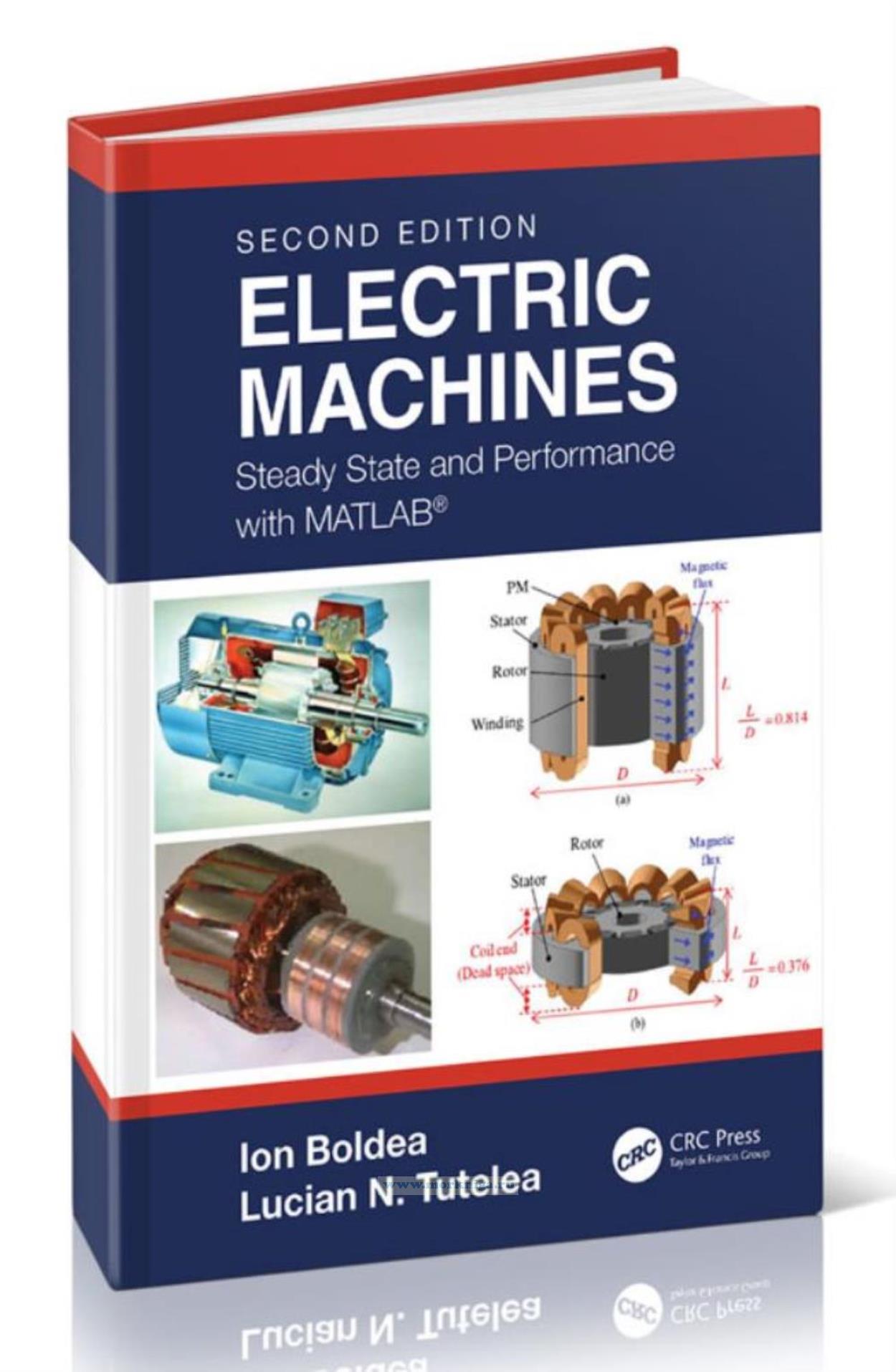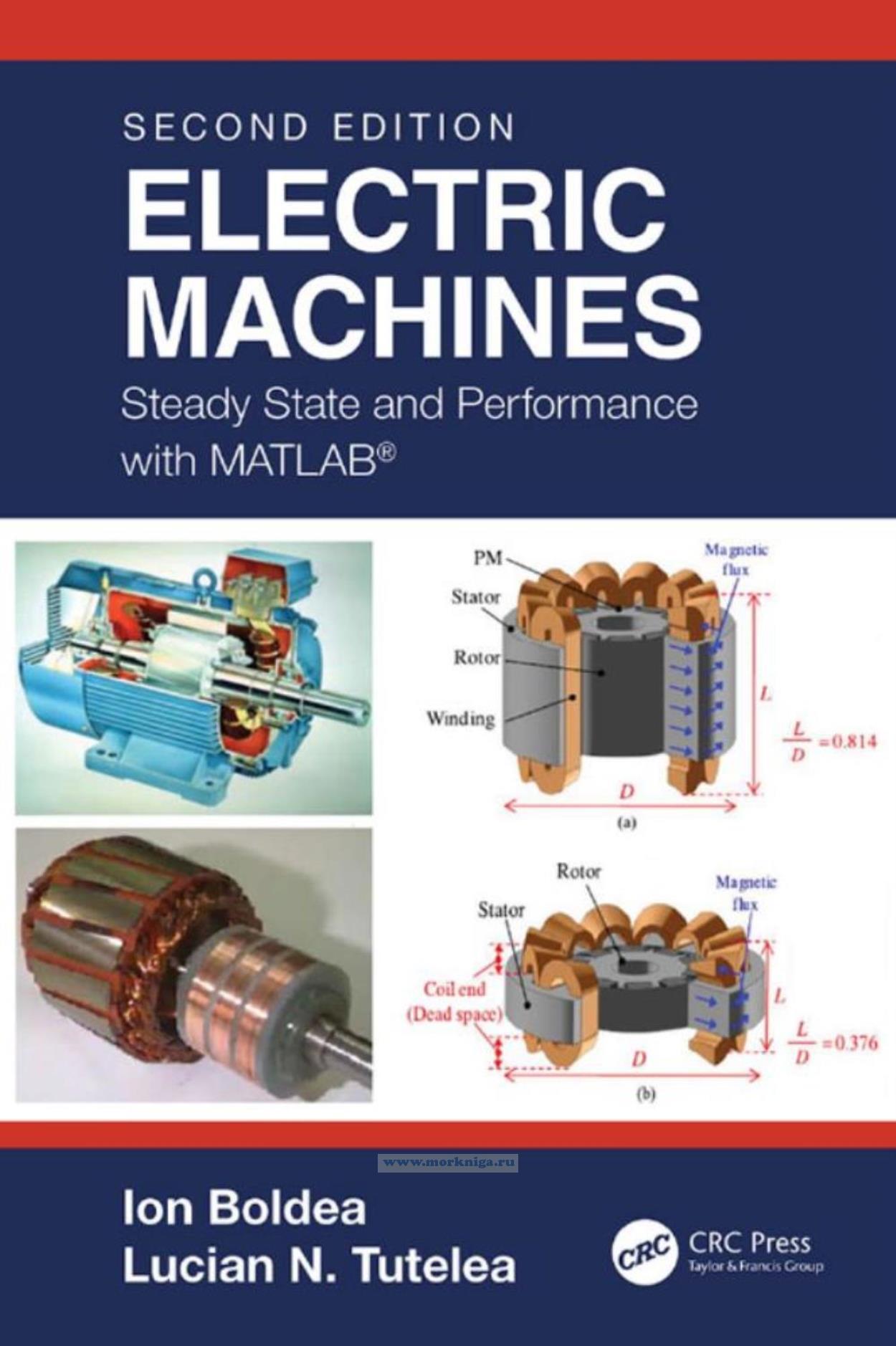Сб с 10 до 16
Electric Machines. Steady State and Performance with Matlab/Электрические машины. Стабильное состояние и производительность с Matlab
Издание на английском языке
Electric energy is paramount to prosperity while inspiring social responsibility of industry.
Intelligent use of electric energy implies better electric generators to “produce” it in modern distributed power systems, with day by day more renewable energy penetration.
It also implies better electric motors used more and more in variable speed drives via power electronics and digital control to save energy and increase productivity in all industries where the output varies in time.
Electric machines are reversible in the sense of switching easily from motoring to generating. New industries such as e-transport, robotics, e-building appliances, renewable (wind) energy have extended quickly recently with similar trends in the near and distant future.
The present textbook is intended as for the first semester treating electric transformers, rotary and linear machines steady-state modeling and performance computation, preliminary dimensioning and testing standardized and innovative techniques. Numerical examples/problems are scattered all over the book to bring a feeling of magnitudes. Proposed problems are available at the end of all 6 chapters; also 9 MATLAB/SIMULINK user-friendly computer programs that illustrate main machine characteristics are available online. The textbook may directly be used also by R&D engineers in industry as all machine parameters and characteristics are calculated by ready to use in industrial design mathematical expressions.
Educating electrical engineering students and R&D engineers in industry in electric machinery and drives faces new challenges as the recent technical progress in the field has been staggering.
Contents
Preface
Authors
Chapter 1 Introduction
1.1 Electric Energy and Electric Machines
1.2 Basic Types of Transformers and Electric Machines
1.3 Losses and Efficiency
1.4 Physical Limitations and Ratings
1.5 Nameplate Ratings
1.6 Methods of Analysis
1.7 State of the Art and Perspective
1.8 Summary
1.9 Proposed Problems
References
Chapter 2 Electric Transformers
2.1 AC Coil with Magnetic Core and Transformer Principles
2.2 Magnetic Materials in EMs and Their Losses
2.3 Electric Conductors and Their Skin Effects
2.4 Components of Single-and Three-Phase Transformers
2.5 Flux Linkages and Inductances of Single-Phase Transformers
2.6 Circuit Equations of Single-Phase Transformers with Core Losses
2.7 Steady State and Equivalent Circuit
2.8 No-Load Steady State (I2 = 0)/Lab 2.1
2.9 Steady-State Short-Circuit Mode/Lab 2.2
2.10 Single-Phase Transformers: Steady-State Operation on Load/Lab 2.3
2.11 Three-Phase Transformers: Phase Connections
2.12 Particulars of Three-Phase Transformers on No Load
2.13 General Equations of Three-Phase Transformers
2.14 Unbalanced Load Steady State in 3-Phase Transformers/Lab 2.5
2.15 Paralleling 3-Phase Transformers
2.16 Transients in Transformers
2.17 Instrument Transformers
2.18 Autotransformers
2.19 Transformers and Inductances for Power Electronics
2.20 Preliminary Transformer Design (Sizing) by Example
2.21 Summary
2.22 Proposed Problems
References
Chapter 3 Energy Conversion and Types of Electric Machines
3.1 Energy Conversion in Electric Machines
3.2 Electromagnetic Torque
3.3 Passive Rotor Electric Machines
3.4 Active Rotor Electric Machines
3.5 Fix Magnetic Field (Brush–Commutator) Electric Machines
3.6 Traveling Field Electric Machines
3.7 Types of Linear Electric Machines
3.8 Flux – Modulation Electric Machines: A New Breed
3.9 Summary
3.10 Proposed Problems
References
Chapter 4 Brush–Commutator Machines: Steady State
4.1 Introduction
4.2 Brush–Commutator Armature Windings
4.3 The Brush–Commutator
4.4 Airgap Flux Density of Stator Excitation MMF
4.5 No-Load Magnetization Curve by Example
4.6 PM Airgap Flux Density and Armature Reaction by Example
4.7 The Commutation Process
4.8 EMF
4.9 Equivalent Circuit and Excitation Connections
4.10 D.C. Brush Motor/Generator with Separate (or PM) Excitation/Lab 4.1
4.11 D.C. Brush PM Motor Steady-State and Speed Control Methods/Lab 4.2
4.12 D.C. Brush Series Motor/Lab 4.3
4.13 A.C. Brush Series Universal Motor
4.14 Testing Brush–Commutator Machines/Lab 4.4
4.15 Preliminary Design of a D.C. Brush PM Automotive Small Motor by Example
4.16 Summary
4.17 Proposed Problems
References
Chapter 5 Induction Machines: Steady State
5.1 Introduction: Applications and Topologies
5.2 Construction Elements
5.3 AC Distributed Windings
5.4 Induction Machine Inductances
5.5 Rotor Cage Reduction to the Stator
5.6 Wound Rotor Reduction to the Stator
5.7 Three-Phase Induction Machine Circuit Equations
5.8 Symmetric Steady State of Three-Phase IMs
5.9 Ideal No-Load Operation/Lab 5.1
5.10 Zero Speed Operation (S = 1)/Lab 5.2
5.11 No-Load Motor Operation (Free Shaft)/Lab 5.3
5.12 Motor Operation on Load (1 > S > 0)/Lab 5.4
5.13 Generating at Power Grid (n > f1/p1,S < 0)/Lab 5.5
5.14 Autonomous Generator Mode (S < 0)/Lab 5.6
5.15 Electromagnetic Torque and Motor Characteristics
5.16 Deep-Bar and Dual-Cage Rotors
5.17 Parasitic (Space Harmonics) Torques
5.18 Starting Methods
5.19 Speed Control Methods
5.20 Unbalanced Supply Voltages
5.21 One Stator Phase Open by Example/ Lab 5.7
5.22 One Rotor Phase Open
5.23 Capacitor Split-Phase Induction Motors/ Lab 5.8
5.24 Linear Induction Motors
5.25 Regenerative and Virtual Load Testing of IMs/Lab 5.7
5.26 Preliminary Electromagnetic IM Design by Example
5.27 Dual Stator Windings Induction Generators (DWIG)
5.28 Summary
5.29 Proposed Problems
References
Chapter 6 Synchronous Machines: Steady State
6.1 Introduction: Applications and Topologies
6.2 Stator (Armature) Windings for SMs
6.3 SM Rotors: Airgap Flux Density Distribution and EMF
6.4 Two-Reaction Principle via Generator Mode
6.5 Armature Reaction and Magnetization Reactances, Xdm and Xqm
6.6 Symmetric Steady-State Equations and Phasor Diagram
6.7 Autonomous Synchronous Generators
6.8 Synchronous Generators at Power Grid/Lab 6.4
6.9 Basic Static-and Dynamic-Stability Concepts
6.10 Unbalanced Load Steady State of SGs/Lab 6.5
6.11 Large Synchronous Motors
6.12 PM Synchronous Motors: Steady State
6.13 Load Torque Pulsations Handling by Synchronous Motors/Generators
6.14 Asynchronous Starting of SMs and Their Self-Synchronization to Power Grid
6.15 Single-Phase and Split-Phase Capacitor PM Synchronous Motors
6.16 Preliminary Design Methodology of a Three-Phase Small Automotive PMSM by Example
6.17 Single Phase PM Autonomous A.C. Generator with Step–Capacitor Voltage Control: A Case Study
6.18 Summary
6.19 Proposed Problems
References
Index

